Kristine Hughes's Blog, page 149
May 17, 2011
Aristocratic Trade
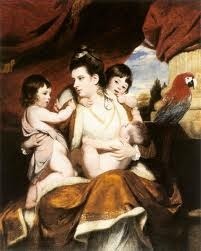
Their 19th century counterparts would no doubt be mortified to learn that today's aristocrats have taken to trade - and are raking in the dosh. Many of England's Stately Homes have been running farm shops for some decades and stock produce and meat sourced locally, but which are not produced by themselves. There are a few exceptions to this, most notably products produced by the Duchy of Cornwall. Recently, Prince Charles launched a five-piece organic treatment line called Highgrove, after his estate in Gloucestershire. It's inspired by plants that grow in the garden of his country house and is already sold out at Organic Pharmacy stores and Prince Charles's Highgrove shops.
 As their copy reads, the "luxurious gift set comprising of Rosemary and Ginger Warming Bath Oil, Arnica and Wintergreen Muscle Balm and Honey and Chamomile Hand Cream. These luxurious products have been specially formulated with organic ingredients including essential oils and naturally occurring, beneficial plant extracts. For use after gardening, exercise or for a relaxing bath."
As their copy reads, the "luxurious gift set comprising of Rosemary and Ginger Warming Bath Oil, Arnica and Wintergreen Muscle Balm and Honey and Chamomile Hand Cream. These luxurious products have been specially formulated with organic ingredients including essential oils and naturally occurring, beneficial plant extracts. For use after gardening, exercise or for a relaxing bath."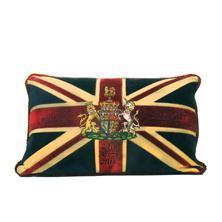
Personally, I'd much rather have this souvenier wedding cushion, also being sold in the Highgrove Shops at just £95.00.

Meanwhile, over at Belvoir Castle, the Duchess has begun selling Duchess of Rutland Botanicals - lightly flavoured, all natural sodas available in two flavours - elderflower and rose and raspberry and lavender. The packaging features peacock feathers from Manners family crest and Regency stripes. Unfortunately, they are not yet available in the US.

At Pulbrook and Gould Flowers, London, Lady Pulbrook didn't let the lack of a stately home to attach her business to stop her from forming a partnership with Rosamund Gould way back in 1956. After the death of her husband, she needed something to occupy her and went into partnership with her friend, trained florist Rosamund Gould. H R H Princess Alexandra and the Duchess of Kent both chose Pulbrook & Gould to arrange memorable flowers at their weddings. As well as members of the Royal Family, they number among their illustrious list of customers aristocrats, stars from throughout the world of entertaining, designers, artists, and the great hostesses of the day, some of Britain's major institutions and businesses and a great many discerning private people whose day is enriched by an arrangement from Pulbrook & Gould. In 1976 Rosamund Gould retired, leaving Lady Pulbrook to grow the business with her sister-in-law, Sonja Waites.
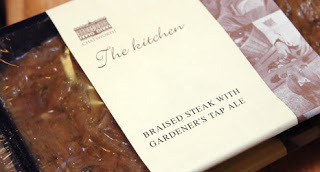
Perhaps the most successful, and the most luscious, aristocratic shop is the Chatsworth Farm Shop at Chatsworth House, which won the prestigious Farm Retailer of the Year award for the second time in 2011. Their newest range are ready meals freshly prepared by Chatsworth chefs using estate produce and local ingredients from the farm shop. You'll find the range in the chilled section of the shop and prices start from £1.75. Meals include beef lasagne, pork & leek sausage in onion gravy, cottage pie topped with Cheddar cheese, fish pie, pork & mushroom casserole in Sheppy cider, chicken breast in tomato, mushroom & tarragon sauce, and braised steak with Gardener's Tap ale. There is also a vegetarian choice of mixed vegetable lasagne.

Chatsworth House itself has four further shops, including The Orangery Shop, which sells beautiful Chatsworth inspired gifts, including favourites chosen by the Duke, Duchess and Lady Burlington. Beautifully themed accessories are inspired by Chatsworth figures from the past and present and a wonderful range of gifts and homeware reflect the House, landscape and collection. I have done some serious damage in this particular shop, with my silver and bone tea spoons being well loved favorites. I don't even mind polishing them. However, only recently I threw out the tin of Chatsworth furniture polish I'd bought there years ago believing that I would be inspired to polish my furniture with museum-like diligence. Never happened - I suppose I'm more Upstairs than Down.
Published on May 17, 2011 00:25
May 16, 2011
The Story of Whitley Hall
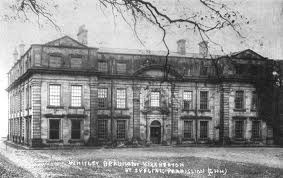 Whitley Hall
Whitley Hall From the Letter Bag of Lady Elizabeth Stanhope
"Another Yorkshire neighbour whom the Stanhopes visited at this date was Mr Beaumont (1) of Whitley Beaumont, and although on this occasion the entry regarding their visit is scanty, a fuller description of their eccentric host, written by Marianne the following autumn, may be here inserted : —
Nov. 1808.
Last Monday we met the Mills' at Grange, she, delightful as usual. We returned the next day, and in our road called on Mr Beaumont of Whitley. The master of Whitley is a strange creature, half mad. He leads the life of a hermit, and has not had a brush, painter or carpenter in his house since he came into possession many, many years ago.
It is more like a haunted house in a romance than anything I ever saw. He is now an old man, and has never bought a morsel of furniture; half the house never was finished; one of the staircases has got no banisters. The stables were burnt down some time ago and have never yet been rebuilt. The rooms he lives in have not been put to rights for many years—a description of the things they contain would not be easy,—hats, wigs, coats, piles of newspapers, magazines and letters, draughts, bottles, wash-hand basins, pictures without frames, apples, tallow candles and broken tea-cups.
The whole house looks like a place for lumber. There are some fine rooms, but so damp and mouldy it is quite shocking. There is a chapel completely filled with old rubbish and a plaid bed which was put up for the Pretender.
In the room Mr Beaumont sleeps in I saw his coffin made of cedar wood. He scarcely ever sees a living creature and quite dislikes the sight of a woman. He does everything in the room, which no housemaid ever enters, nor indeed any part of the house."
(1) John Beaumont, Esquire of Whitley Beaumont, Yorkshire, born 1752, died 1831; married Sarah, daughter of Humphrey Butler, Esquire of Hereford.
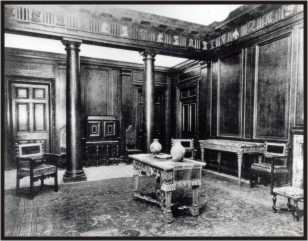
The house referred to above, Whitely Beaumont Hall, was owned by the Beaumont family for some 400 years. The Hall was built by Sir Richard Beaumont and was last owned and occupied by the Sutcliffe family, the last owner being Charles Sutcliffe. His great nephew wrote in the Yorkshire Post and recalled visiting the "secret garden" and sitting on an old World War One field gun kept in the front garden.
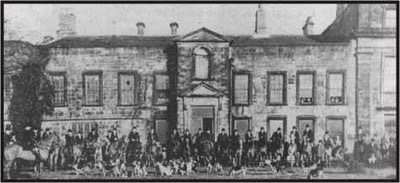
Charles Sutcliffe was a member of the Rockwood Hunt and hunt balls were held in Whitley's great hall. During the Second World War, Charles Sutcliffe loaned the grounds for army training manoeuvres and camps. The Sutcliffe family were the largest individual maltsters in Great Britain with kilns in many parts of northern England, many of which were in Wakefield. Charlie Sutcliffe died in 1948.
Scouts first camped at Whitley Beaumont in 1928, Charles Sutcliffe allowed Scouts to camp in the hall's kitchen garden. There is some question over the exact date, some locals suggest 1928, whilst Huddersfield Scout archives suggest that the first use was in 1929. By October 1935 it was recorded in the local area records that "the estate manager had allowed Scouts to camp at Whitley Hall and 102 weekend camps had been arranged."
Peter Hinchliffe in the Examiner, June 26th 1998, referred to earlier times when his mother as a 16 year old witnessed the auction of the "fittings of the mansion" Wednesday May 16th 1917. These included an Elizabethan and a Georgian mantel piece in marble, and oil paintings by Italian masters. He notes that the Hall fell into disrepair and that Charlie Sutcliffe described it as his "shooting box." He entertained friends by candlelight, as there was no electricity.
Peter recalls sneaking up to peer in at the windows while a military ball was in progress, during the war, and then the auction at the Three Nuns in 1950 when the Hall was bought by a Halifax demolition firm for £2500 and the woodlands and parklands sold off for some £20,000. The hall was demolished in the early 1950's and the area surrounding the site was extensively open-cast mined. Parts of the property remain a scout camp.
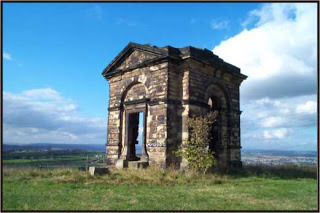
The ruins of a Summer House, or Temple, are all that remain of Whitley Hall.
Published on May 16, 2011 00:00
May 15, 2011
Headfort Place
Located just off Belgrave Square, I came across Headfort Place when walking back to the Rubens Hotel from Apsley House.
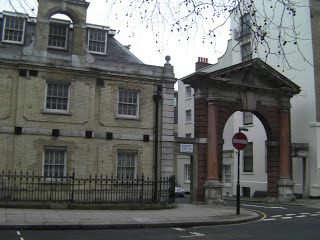
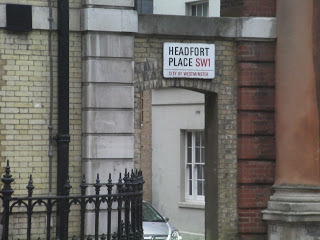
The title of the Marquis of Headfort was an Irish peerage conferred in 1800, which explains why I was able to find information on their Irish property - Headfort Hall estate in County Meath, now a school - but little on Headfort Place, London.
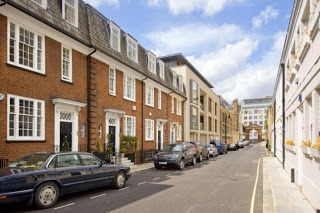
One of the freehold houses in Headfort Place is currently on the market for four million pounds. The Railway Industry Association and Unisea Maritime have offices here.
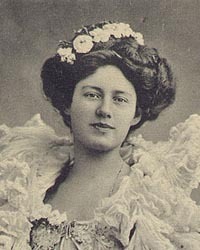
In 1901, the fourth Marquis caused quite a stir when he married Miss Rosa (Rosie) Boote, above, a Florodora dancer at the Gaiety Theatre. To read an in-depth article artice on Rosie, and for more fabulous photos, click here. For a more in depth look at the wild lives of some of the latest title holders, click here.
You can see a property for sale by Harrod's Estates in Headfort Place here.
Can anyone provide further details regarding Headfort Place?


The title of the Marquis of Headfort was an Irish peerage conferred in 1800, which explains why I was able to find information on their Irish property - Headfort Hall estate in County Meath, now a school - but little on Headfort Place, London.

One of the freehold houses in Headfort Place is currently on the market for four million pounds. The Railway Industry Association and Unisea Maritime have offices here.

In 1901, the fourth Marquis caused quite a stir when he married Miss Rosa (Rosie) Boote, above, a Florodora dancer at the Gaiety Theatre. To read an in-depth article artice on Rosie, and for more fabulous photos, click here. For a more in depth look at the wild lives of some of the latest title holders, click here.
You can see a property for sale by Harrod's Estates in Headfort Place here.
Can anyone provide further details regarding Headfort Place?
Published on May 15, 2011 00:43
May 14, 2011
Victoria Goes Traveling

From May 17 to June 16, I will be traveling, first flying to Lisbon, Portugal, for a couple of days before departing on a cruise which will eventually take my husband and me to Dover, England, arriving June 3. I have visited Lisbon before, a fascinating city which has many British connections.

On our last visit, we hired a car and driver to take us to Torre Vedras, the Peninsular War fortifications erected at the direction of Lord Wellington, commander of the British forces in the Peninsular War, and to the site of the Battle of Vimiero in 1808. I will write more about that trip soon.
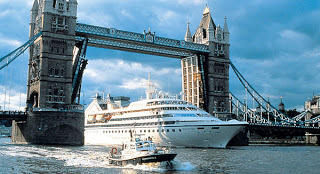
We will board the ship Seabourn Pride in Lisbon and embark on a cruise up the coast of Portugal, Spain and France, eventually entering the English Channel and ending up in Dover. The photo above shows the Pride on the Thames. A few years ago we were aboard, leaving from London to cruise the Baltic, but this time we will conclude our trip in Britain rather than begin it there.
[image error]
Two of our stops will be in Spain. La Coruna in Galicia is near Santiago de Compostela and our second Spanish port will be Santander, below, from which British troops were supplied for the last years of the Peninsular War by the Royal Navy. Santander's port is said to be excellent.
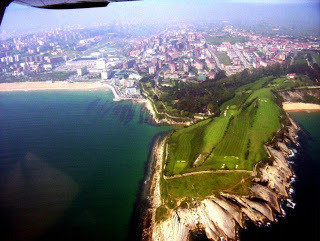
In La Coruna, perhaps we will be able to visit the tomb (below) of General Sir John Moore (1761-1809) who died leading British troops in the Battle of Coruna. For more about General Moore, see this blog of May 10, 2011.
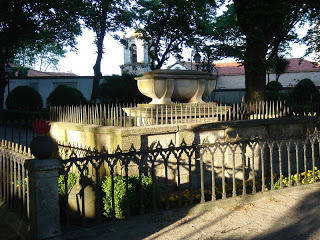 Moore's tomb is in los Jardines de San Carlos, a popular public garden.
Moore's tomb is in los Jardines de San Carlos, a popular public garden.We will cruise up the Garonne River to Bordeaux, France. There I will abandon all pretense at finding anything more British than their love for claret! I am looking forward to seeing some of the world's great vineyards.
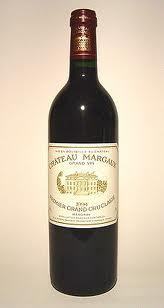
After visiting Belle Isle, France, we will arrive at the Isle of Guernsey, and dock in St Peter's Port. I suppose we will have many references to Potato Peel Pie. What fun -- I loved the novel.
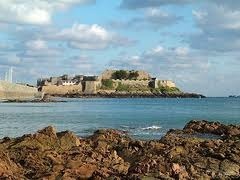
I hope we will have a good opportunity see see the sights of Guernsey...a place I have always wanted to visit. How about you? Do the Channel Islands hold a fascination for you too? I wonder why?
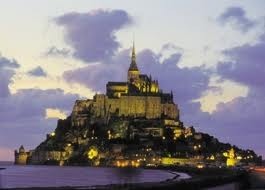
Our next stop will be to visit Mont St Michel, though I assume the ship will find a better berth than the sandy spit which leads to the mont, reputed to disappear with the incoming tide.
Our last stop in France will be in Rouen, up the Seine in Normandy. We have several days there and look forward to seeing the WWII landing beaches and cemeteries, Monet's garden at Giverny, as well as the city itself.
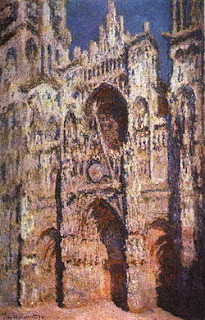 Monet: Rouen Cathedral 1894
Monet: Rouen Cathedral 1894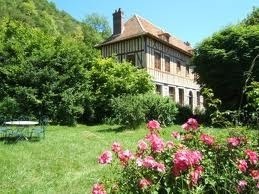 Monet's house and garden at Giverny
Monet's house and garden at Giverny If we arrange things efficiently we might even manage a visit to Versailles. I was there many years ago, at age 20, and all we could do was make fun of the over-the-top pretentiousness of the palace. Today, I 'd appreciate it differently, and I'd love to see the gardens. (Is travel wasted on the young?)
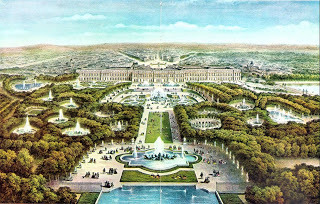
Our final port on the Seabourn Pride will be in Dover. Although I know I will be sad to leave the wonderful ship and its friendly crew -- particularly the complete indulgence with which we are treated -- I have more adventures ahead in England, about which I will write soon.
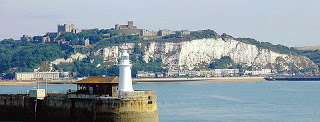
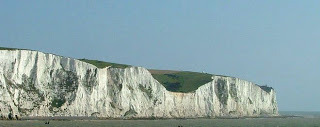 (That strange noise you've been hearing as you read this post is the sound of Kristine - who is not going along on this trip - sobbing in the background. Stop it! Yes, I know Artie was at La Coruna. For pity's sake, I'll bring you back a t-shirt. Look at you, you're a mess. Blow your nose! And watch your language. We have guests. Honestly . . . .)
(That strange noise you've been hearing as you read this post is the sound of Kristine - who is not going along on this trip - sobbing in the background. Stop it! Yes, I know Artie was at La Coruna. For pity's sake, I'll bring you back a t-shirt. Look at you, you're a mess. Blow your nose! And watch your language. We have guests. Honestly . . . .)
Published on May 14, 2011 02:00
May 12, 2011
The Wellington Connection - The Marchioness of Worcester
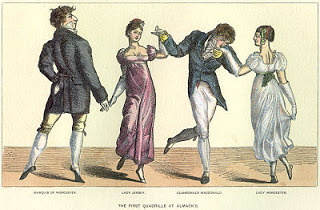 The first quadrille was danced at Almack's - pictured are the Marquis of Worcester, Lady Jersey, Claronald Macdonald and Lady Worcester.
The first quadrille was danced at Almack's - pictured are the Marquis of Worcester, Lady Jersey, Claronald Macdonald and Lady Worcester.The Duke of Wellington's ties to the Marquis and Lady Worcester were fastened on both sides - Lord Worcester had served as an aide-de-camp to the Duke of Wellington during the Peninsular War, while the Marchioness of Worcester, Georgina Frederica, was the daughter of the Hon. Henry Fitzroy and the Duke's sister, Lady Anne, and therefore Wellington's niece. Prior to their marriage, Lady Shelly wrote in her diary, "Georgiana Fitzroy's marriage was announced. It was to take place on the following Monday, when the Duke was to give her away. I hope that it will turn out well, but I have my doubts! Lord Worcester is only twenty-one, and very wild."
The marriage proved happy enough but, at the age of 28, Georgina became gravely ill. The following account is from The Letter Bag of Lady Elizabeth Spencer-Stanhope - " . . . Lady Worcester was not expected to live thro' last night. She was at the Birthday and at the ball, danced a great deal, felt unwell, and was fool enough to take a shower bath before she went to bed. She was seized with inflammation in her bowels and in great danger immediately. Lady Worcester's sufferings were most extreme, her complaint a twisting of the guts. She died sensible but screaming. On one side of the bed sat Lady E. Vernon, on the other, Lady Jersey, also screaming with grief. The Duke of Wellington had to drag them by force out of the room. There were eighty people standing round when she died."
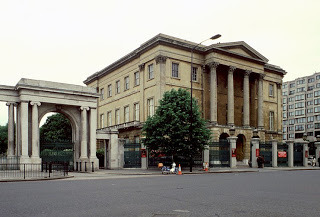 Apsley House
Apsley HouseThe New Monthly Magazine ran the following report about her death on May 11, 1821 — At Apsley House, the Marchioness of Worcester, of an internal inflammation. Her Ladyship was Georgiana Frederica Fitzroy, eldest daughter of the late Hon. Henry Fitzroy, son of Charles, first Lord Southampton, brother of the Duke of Grafton, by Lady Anne Wellesley, sister of the Duke of Wellington and Marquis Wellesley; and was married to the Marquis of Worcester on the 25th of July, 1814. Her Ladyship was one of the most intimate and favourite friends of the late Princess Charlotte.
And from the Greville Diary - May 12th.—I have suffered the severest pain I ever had in my life by the death of Lady Worcester.1 I loved her like a sister, and I have lost one of the few persons in the world who cared for me, and whose affection and friendship serve to make life valuable to me. She has been cut off in the prime of her life and in the bloom of her beauty, and so suddenly too. Seven days ago she was at a ball at Court, and she is now no more. She died like a heroine, full of cheerfulness and courage to the last. She has been snatched from life at a time when she was becoming every day more fit to live, for her mind, her temper, and her understanding were gradually and rapidly improving; she had faults, but her mind was not vicious, and her defects may be ascribed to her education and to the actual state of the society in which she lived. Her virtues were inherent in her character; every day developed them more and more, and they were such as to make the happiness of all who lived with her and to captivate the affection of all who really knew her. I have never lost anyone I loved before, and though I know the grief I now feel will soon subside (for so the laws of nature have ordained), long, long will it be before I forget her, or before my mind loses the lively impression of her virtues and of our mutual friendship.
"This is one of those melancholy events in life to which the mind cannot for a long time reconcile or accustom itself. I saw her so short a time ago ' glittering like the morning star, full of life and splendour and joy;' the accents of her voice still so vibrate in my ear that I cannot believe I shall never see her again. What a subject for contemplation and for moralising! What reflections crowd into the mind!
"Dr. Hume told me once he had witnessed many death beds, but he had never seen anything like the fortitude and resignation displayed by her. She died in his arms, and without pain. As life ebbed away her countenance changed, and when at length she ceased to breathe, a beautiful and tranquil smile settled upon her face."
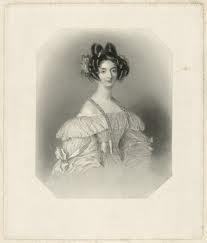 Emily, Duchess of Beaufort
Emily, Duchess of BeaufortAs stated above, Lady Worcester died on 11 May 1821, and on 29 June 1822, her husband Lord Worcester married Lady Anne's other daughter, Emily Frances. This opens up a whole can of worms, as it was against the law for a widow or widower to marry a brother or sister-in-law. How did they get around this? It might have been due to the fact that Emily had been Lady Worcester's half sister - their mother, Lady Anne's husband, Henry Fitzroy died on the 19 March 1794, and on 2 August 1799 Lady Anne was remarried to Charles Culling Smith. Their daughter Emily Frances Smith was born on the 3 March 1800.
On 23 November, 1835 Emily became the Duchess of Beaufort. She died on 2 October 1889 at age 89 and was buried at Badminton. Her mother, Lady Anne Smith, died in 1844.
Published on May 12, 2011 01:21
May 11, 2011
From the Pen of Horace Walpole
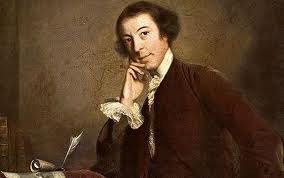 Horace Walpole
Horace Walpole
To George Montagu, Esquire
Arlington Street, May 11, 1769
. . . . . Strawberry (Hill) has been in great glory; I have given a festino there that will almost mortgage it. Last Tuesday all France dined there: Monsieur and Madame du Chatelet, the Due de Liancourt, three more French ladies, whose names you will find in the enclosed paper, eight other Frenchmen, the Spanish and Portuguese ministers, the Holdernesses, Fitzroys, in short we were four and twenty. They arrived at two at the gates of the castle I received them, dressed in the cravat of Gibbons's carving, and a pair of gloves embroidered up to the elbows that had belonged to James the First. The French servants stared, and firmly believed this was the dress of English country gentlemen. After taking a survey of the apartments, we went to the printing-house, where I had prepared the enclosed verses, with translations by Monsieur de Lille, one of the company. The moment they were printed off, I gave a private signal, and French horns and clarioiets accompanied this compliment. We then went to see Pope's grotto and garden, and returned to a magnificent dinner in the refectory. In the evening we walked, had tea, coffee,and lemonade in the gallery, which was illuminated with a thousand, or thirty candles, I forget which, and played at whist and loo till midnight. Then there was a cold supper and at one the company returned to town, saluted by fifty nightingales, who, as tenants of the manor, came to do honour to their lord.
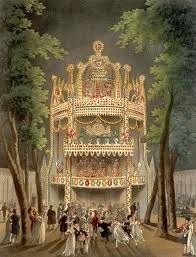 Vauxhall Gardens
Vauxhall Gardens
I cannot say last night was equally agreeable. There was what they called a ridotto el fresco at Vauxhall, for which one paid half-a-guinea, though, except some thousand more lamps and a covered passage all round the garden, which took off from the gardenhood, there was nothing better than on a common night. Mr. Conway and I set out from his house at eight o'clock; the tide and torrent of coaches was so prodigious, that it was half-an-hour after nine before we got half way from Westminster-bridge. We then alighted; and after scrambling under bellies of horses, through wheels, and over posts and rails, we reached the gardens, where were already many thousand persons. Nothing diverted me but a man in a Turk's dress and two nymphs in masquerade without masks, who sailed amongst the company, and, which was surprising, seemed to surprise nobody. It had been given out that people were desired to come in fancied dresses without masks. We walked twice round and were rejoiced to come away, though with the same difficulties as at our entrance; for we found three strings of coaches all along the road, who did not move half a foot in half-an-hour. There is to be a rival mob in the same way at Ranelagh to-morrow; for the greater the folly and imposition the greater is the crowd. I have suspended the vestimenta that were torn off my back to the god of repentance, and shall stay away. Adieu! I have not a word more to say to you. Yours ever.
P. S. I hope you will not regret paying a shilling for this packet.

 Horace Walpole
Horace Walpole To George Montagu, Esquire
Arlington Street, May 11, 1769
. . . . . Strawberry (Hill) has been in great glory; I have given a festino there that will almost mortgage it. Last Tuesday all France dined there: Monsieur and Madame du Chatelet, the Due de Liancourt, three more French ladies, whose names you will find in the enclosed paper, eight other Frenchmen, the Spanish and Portuguese ministers, the Holdernesses, Fitzroys, in short we were four and twenty. They arrived at two at the gates of the castle I received them, dressed in the cravat of Gibbons's carving, and a pair of gloves embroidered up to the elbows that had belonged to James the First. The French servants stared, and firmly believed this was the dress of English country gentlemen. After taking a survey of the apartments, we went to the printing-house, where I had prepared the enclosed verses, with translations by Monsieur de Lille, one of the company. The moment they were printed off, I gave a private signal, and French horns and clarioiets accompanied this compliment. We then went to see Pope's grotto and garden, and returned to a magnificent dinner in the refectory. In the evening we walked, had tea, coffee,and lemonade in the gallery, which was illuminated with a thousand, or thirty candles, I forget which, and played at whist and loo till midnight. Then there was a cold supper and at one the company returned to town, saluted by fifty nightingales, who, as tenants of the manor, came to do honour to their lord.
 Vauxhall Gardens
Vauxhall Gardens I cannot say last night was equally agreeable. There was what they called a ridotto el fresco at Vauxhall, for which one paid half-a-guinea, though, except some thousand more lamps and a covered passage all round the garden, which took off from the gardenhood, there was nothing better than on a common night. Mr. Conway and I set out from his house at eight o'clock; the tide and torrent of coaches was so prodigious, that it was half-an-hour after nine before we got half way from Westminster-bridge. We then alighted; and after scrambling under bellies of horses, through wheels, and over posts and rails, we reached the gardens, where were already many thousand persons. Nothing diverted me but a man in a Turk's dress and two nymphs in masquerade without masks, who sailed amongst the company, and, which was surprising, seemed to surprise nobody. It had been given out that people were desired to come in fancied dresses without masks. We walked twice round and were rejoiced to come away, though with the same difficulties as at our entrance; for we found three strings of coaches all along the road, who did not move half a foot in half-an-hour. There is to be a rival mob in the same way at Ranelagh to-morrow; for the greater the folly and imposition the greater is the crowd. I have suspended the vestimenta that were torn off my back to the god of repentance, and shall stay away. Adieu! I have not a word more to say to you. Yours ever.
P. S. I hope you will not regret paying a shilling for this packet.
Published on May 11, 2011 01:19
May 10, 2011
The Brothers Moore
You may recall that we were first introduced to the Moore brothers in a post called Early Rumblings of a Regency that ran on March 7.
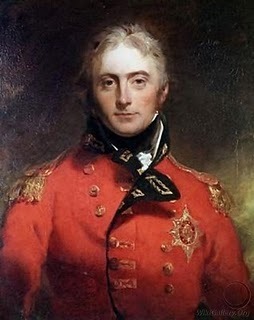
General Sir John Moore(1761-1809)
After reading the pithy letters of General Sir John Moore and his brother, Captain Graham Moore, I was prompted to do more research into the lives of these men and, perhaps unsurprisingly, things were once again brought round to the Duke of Wellington, to whom all roads seem to inevitably lead.
Commissioned at the age of 15, Sir John Moore served in the American War of Independence and within eight years was a member of parliament. In 1794 he was involved with the British backing of Paoli's conquest of Corsica and then served in West Indies. He became a major general in 1798 and took part in operations in Holland and Egypt, where he was a leading player in defeating the French at the second battle of Aboukir.
Perhaps his most important military role came when he assumed command of the British forces in the Iberian peninsula following the recall of Harry Burrard of Lymington, Hew Dalrymple and Arthur Wellesley, who were all at that time facing an inquiry over the Convention of Cintra on the French troops' evacuation from Portugal.
Wellington returned to London and met with Castlereagh, informing him both as to the feelings of Sir John Moore and the estimation in which that officer was held by the army in Portugal. The following letter from Wellington to Sir John sufficiently explains the result of the interview:—
To Lieut.-General Sir John Moore, E.B. London, 8th Oct., 1808.
My Dear General,
" I arrived in London on Thursday, and I yesterday took an opportunity of mentioning to Lord Castlereagh what I told you I should, notwithstanding that I found, upon my arrival in England, that the object I had in view in conversing with you upon this subject at all had been accomplished by your appointment to command the army. I told Lord Castlereagh that you thought that Government had not treated you well, and that you had considered it incumbent upon you to express your sentiments upon that treatment; but that after you had done so, you had thought no more of the matter, and that it would be found that you would serve as cordially and as zealously in any situation in which you might be employed as if nothing of the kind had ever passed.
" Lord Castlereagh said that he had never entertained any doubt upon this subject; and that after he had communicated to you the sentiments of the King's Government upon what had passed, his only wish respecting you had been to employ you in the manner in which you were most likely to be useful to the country.
" I find that by the distribution I am placed under your command, than which nothing can be more satisfactory to me. I will go to Coruna immediately, where I hope to find you.
" You'll have seen by the newspapers that the late transactions in Portugal have made a stronger sensation here than it was imagined they would, and I have had what I think more than my share of the blame. I suppose that there must be an inquiry into the transactions; and till that takes place, I shall leave the public to find out the truth in the best way they can, and shall not adopt any illegitimate mode of setting them right. In the mean time the abuse of the news-writers of London will not deprive me of my temper or my spirits, or of the zeal with which I will forward every wish of yours.
Ever, etc.,Arthur Wellesley
" Since writing the above I find that it will be necessary that I should wait in England till Sir Hugh Dalrymple will return, and it will be known at what time the inquiry will be made into the late transactions in Portugal on which I am to be examined. I will join you, however, the moment I am set at liberty, for which I long most anxiously. I send a duplicate of this letter to Coruna."
Wellington's hoped for reunion with Moore was not to be. Sir Arthur departed for Ireland, where, indifferent to the wrong which was done him by the English people, he resumed the course of his civil duties. There he remained till the beginning of November, when the assembling at Chelsea Hospital of the Court to inquire into the circumstances of the late campaign, and of the convention in which it resulted, recalled him to London. In common with Sir Hugh Dalrymple and Sir Harry Burrard, he appeared before the Court, where each gave his own statement, and supported it by his own line of argument. There is no reason now to conceal or disguise the fact, that the conclusions at which the Court arrived were all pretty well arranged beforehand. Sir Arthur, still treating with the utmost possible delicacy officers who were not by any means so delicate towards him, proved his own case. The Court listened with partial ears to the statements of Sir Hugh and Sir Harry; and the final issue was a declaration, that nobody was to blame; that all which could have been reasonably expected under the circumstances, had been done, so that further proceedings in the case were not necessary. Absurd as the decision was, Sir Arthur made no protest against it; but returned to Ireland and busied himself as before in such affairs as came usually under the cognizance of chief secretaries.
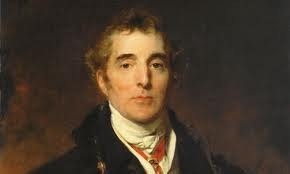
Time passed, and early in January, 1809, Parliament met. One of the first acts of both Houses was to pass a vote of thanks to Sir Arthur Wellesley and the army which had served under him; a measure which pleased him, not alone because his own good name was thereby vindicated, but because the impediments were removed which had heretofore stood between his friend General Spencer and the honours for which he had recommended him.
It was natural enough that the British Government should make Spain, rather than Portugal, the first object of their care. Spain was the larger and more populous country of the two, and it had been impressed upon their minds by Sir John Moore, and indeed by all whom they had heretofore consulted, that to defend Portugal after Spain should have been overrun was impossible. Lord Castlereagh therefore proposed to the Junta of Seville, which had by this time assumed the functions of Supreme Government, that Cadiz should become the base of operations for a British army; and then, and not till then, he bethought him of consulting Sir Arthur Wellesley. On the 7th of March he received in reply a memorandum, which not only answered every question proposed, but took a view of the case so masterly and comprehensive as to leave no single point connected with it untouched.
Sir Arthur begins that remarkable paper in these words - " I have always been of opinion that Portugal might be defended, whatever might have been the result of the contest in Spain, and that in the mean time the measures adopted for the defence of Portugal would lie highly useful to the Spaniards in their contest with the French." He then goes on to justify this assertion, and to explain that in Portugal, with its feeble Government and docile population, a native army could be officered by Englishmen, which being intermixed with English troops, would soon be rendered capable of facing the best of the Continental armies. It was thus that at every new stage in his career the Great Duke was accustomed to turn to account the experience which the past had given him.
Wellington described Napoleon's political system as one of terror, which must crumble to pieces if once effectually checked; and he expressed a belief that in Portugal, if wisely dealt with, the first decided check would be given to that system. Sir Arthur's minute was read in Cabinet, and produced a strong effect, and the refusal of the Spaniards to receive a British garrison into Cadiz arriving not long afterwards, Sir Arthur's views were unanimously adopted. There remained then but one course for the Government to follow. Sir Arthur was requested to assume the command of the army, which it was determined to employ in the Peninsula, and he did so without a moment's hesitation.
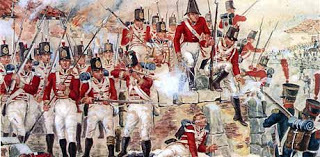
When Napoleon arrived in Spain with 200,000 men, Moore drew the French northwards while retreating to his embarkation ports of A Coruña and Vigo. Moore established a defensive position on hills outside the town, while being guarded by the 15th Hussars, and was fatally wounded at the Battle of Corunna, being "struck in his left breast and shoulder by a cannon shot, which broke his ribs, his arm, lacerated his shoulder and the whole of his left side and lungs." He remained conscious, and composed, throughout the several hours of his dying, amongst his final words being "Remember me to your sister, Stanhope," referring to his friend, the intrepid Near East Asia traveler Lady Hester Stanhope, to whom it was rumoured he hoped to be wed. Moore lived long enough to learn of his victory. He said to his old friend Colonel Anderson "You know I always wished to die this way." His last words were "I hope the people of England will be satisfied! I hope my country will do me justice!" He was buried wrapped in a military cloak in the ramparts of the town. Moore's military tactics were so brilliant that Moore's French rival, Marshall Soult, erected a memorial in his honour at Corunna. The Duke of Wellington declared that his victory at Waterloo would have been impossible without his predecessor, who had ensured the survival of a credible British fighting force. Moore's memory was honoured by Charles Wolfe's poem, The Burial of Sir John Moore after Corunna , which ensured that generations of schoolchildren would learn of his heroism.
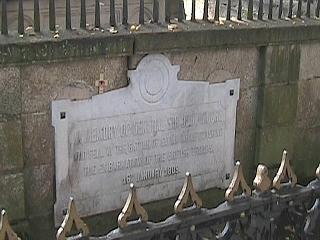
The commemorative plaque on Moore's stone tomb in the Jardin de San Carlos, in the old town of A Coruna
Moore had died on died 16th January 1809 and Wellington did not reach Lisbon in April 1809, only to find that the French had again pressed south into Portugal, against dwindling Portuguese and Spanish opposition, and captured Oporto. Whilst he and Moore had not met again, Wellington did not forget his fallen commrade in arms, as the following letter shows.
To F. Moore, Esq. Vera, 24th October, 1813.
Sir,
'I have received your letter of the 30th September, and you do me justice in believing that I feel every inclination to forward, as far as may be in my power, the views of your son * in the service, on account of his late uncle, and, what perhaps may be more satisfactory to you, on account of his own merits.
'He is now attached to the staff of Sir J. Hope, but as soon as he is sufficiently high in rank to be employed on the General Staff of the army, you may depend on my taking the earliest opportunity which may offer of so employing him if he should prefer it to being attached as aide de camp to any General officer.
I have the honor to be, etc.
Wellington
*Lieut. Colonel W. Moore, nephew to the late Lieut. General Sir John Moore, K.B.
You can read the Diary of Sir John Moore here.
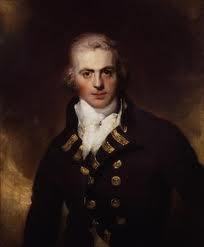 Captain Graham Moore
Captain Graham Moore
The younger Moore brother, Graham, joined the navy, rather than the army, and was made Post-Captain soon after the start of the Revolutionary War, commanding the 36 gun frigate HMS Melampus from 1800, before being appointed to HMS Indefatigable in 1803. Moore later commanded the squadron of four Royal Navy frigates - Indefatigable, Medusa, Lively and Amphion - that captured a Spanish treasure fleet of four frigates carrying bullion from the Caribbean back to Spain off Cadiz in the Action of 5 October 1804.
Moore was then attached to Sir Robert Calder's squadron blockading Ferrol. In 1808, he served as Commodore, flying his broad pendant in the new ship HMS Marlborough assisting Admiral Sir Sidney Smith with the Portuguese royal family's escape to Brazil. He later served as part of the North Sea fleet for several years. He was promoted to Rear-Admiral in 1812, and became Second-in-Command, Mediterranean Fleet in 1815 and served on the Board of Admiralty between 1816 and 1820, being promoted to Vice-Admiral in 1819. He was Commander-in-Chief, Mediterranean Fleet between 1820 and 1823. He was Commander-in-Chief, Plymouth from 1839 to 1842 and flew his flag in HMS Impregnable.
Moore kept a detailed diary from 1784 until 1806, later published in thirty-seven volumes, which provides a unique account of his service as Lieutenant, Commander and Captain. Canada's Sir Graham Moore Islands, Cape Graham Moore, and Graham Moore Bay are named in his honor.
Though Graham's life reads rather like the Wikipedia entry from which it was shamelessly lifted, I'm happy to report that he retained the sense of humour we first met in the letters included in a previous post. Of Lord Nelson Graham wrote that Nelson's be-medalled and be-ribboned dress at the Sicilian Court made a 'pitiful impression ... more like a Prince of an Opera than the Conqueror of the Nile.'
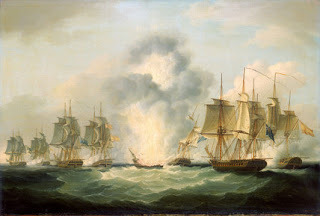 Four frigates capturing Spanish treasure ships, 5 October 1804
Four frigates capturing Spanish treasure ships, 5 October 1804
copyright The National Maritime Museum
From The National Maritime Museum Website: Four Spanish frigates with a rich shipment from Montevideo headed for Cadiz. The cargo was ultimately destined for France and therefore potentially for use against the British. Four British frigates lay in wait to capture them and the two squadrons met on 5 October. The senior British commander Captain Graham Moore asked the Spanish Admiral to surrender. When he refused, action commenced, and within ten minutes the Spanish 'Mercedes' had blown up with the loss of all but one officer and 45 men. Half an hour later the Spanish ships 'Medea' and 'Clara' both surrendered. The Spanish 'Fama' tried to escape but also surrendered after she was chased by the British 'Lively'. Sartorius has arranged the eight ships of the two opposing squadrons across the canvas in pairs. In the right foreground the 'Lively fires into the 'Clara'. Ahead of them is the exploding 'Mercedes' with the stern of the British 'Amphion' beyond her. To the left and ahead the British 'Indefatigable' and Spanish 'Medea' on the right are in close action. Beyond them the British 'Medusa' and Spanish 'Fama' are also firing at each other. The painting is signed and dated 'F. Sartorius 1807.'


General Sir John Moore(1761-1809)
After reading the pithy letters of General Sir John Moore and his brother, Captain Graham Moore, I was prompted to do more research into the lives of these men and, perhaps unsurprisingly, things were once again brought round to the Duke of Wellington, to whom all roads seem to inevitably lead.
Commissioned at the age of 15, Sir John Moore served in the American War of Independence and within eight years was a member of parliament. In 1794 he was involved with the British backing of Paoli's conquest of Corsica and then served in West Indies. He became a major general in 1798 and took part in operations in Holland and Egypt, where he was a leading player in defeating the French at the second battle of Aboukir.
Perhaps his most important military role came when he assumed command of the British forces in the Iberian peninsula following the recall of Harry Burrard of Lymington, Hew Dalrymple and Arthur Wellesley, who were all at that time facing an inquiry over the Convention of Cintra on the French troops' evacuation from Portugal.
Wellington returned to London and met with Castlereagh, informing him both as to the feelings of Sir John Moore and the estimation in which that officer was held by the army in Portugal. The following letter from Wellington to Sir John sufficiently explains the result of the interview:—
To Lieut.-General Sir John Moore, E.B. London, 8th Oct., 1808.
My Dear General,
" I arrived in London on Thursday, and I yesterday took an opportunity of mentioning to Lord Castlereagh what I told you I should, notwithstanding that I found, upon my arrival in England, that the object I had in view in conversing with you upon this subject at all had been accomplished by your appointment to command the army. I told Lord Castlereagh that you thought that Government had not treated you well, and that you had considered it incumbent upon you to express your sentiments upon that treatment; but that after you had done so, you had thought no more of the matter, and that it would be found that you would serve as cordially and as zealously in any situation in which you might be employed as if nothing of the kind had ever passed.
" Lord Castlereagh said that he had never entertained any doubt upon this subject; and that after he had communicated to you the sentiments of the King's Government upon what had passed, his only wish respecting you had been to employ you in the manner in which you were most likely to be useful to the country.
" I find that by the distribution I am placed under your command, than which nothing can be more satisfactory to me. I will go to Coruna immediately, where I hope to find you.
" You'll have seen by the newspapers that the late transactions in Portugal have made a stronger sensation here than it was imagined they would, and I have had what I think more than my share of the blame. I suppose that there must be an inquiry into the transactions; and till that takes place, I shall leave the public to find out the truth in the best way they can, and shall not adopt any illegitimate mode of setting them right. In the mean time the abuse of the news-writers of London will not deprive me of my temper or my spirits, or of the zeal with which I will forward every wish of yours.
Ever, etc.,Arthur Wellesley
" Since writing the above I find that it will be necessary that I should wait in England till Sir Hugh Dalrymple will return, and it will be known at what time the inquiry will be made into the late transactions in Portugal on which I am to be examined. I will join you, however, the moment I am set at liberty, for which I long most anxiously. I send a duplicate of this letter to Coruna."
Wellington's hoped for reunion with Moore was not to be. Sir Arthur departed for Ireland, where, indifferent to the wrong which was done him by the English people, he resumed the course of his civil duties. There he remained till the beginning of November, when the assembling at Chelsea Hospital of the Court to inquire into the circumstances of the late campaign, and of the convention in which it resulted, recalled him to London. In common with Sir Hugh Dalrymple and Sir Harry Burrard, he appeared before the Court, where each gave his own statement, and supported it by his own line of argument. There is no reason now to conceal or disguise the fact, that the conclusions at which the Court arrived were all pretty well arranged beforehand. Sir Arthur, still treating with the utmost possible delicacy officers who were not by any means so delicate towards him, proved his own case. The Court listened with partial ears to the statements of Sir Hugh and Sir Harry; and the final issue was a declaration, that nobody was to blame; that all which could have been reasonably expected under the circumstances, had been done, so that further proceedings in the case were not necessary. Absurd as the decision was, Sir Arthur made no protest against it; but returned to Ireland and busied himself as before in such affairs as came usually under the cognizance of chief secretaries.

Time passed, and early in January, 1809, Parliament met. One of the first acts of both Houses was to pass a vote of thanks to Sir Arthur Wellesley and the army which had served under him; a measure which pleased him, not alone because his own good name was thereby vindicated, but because the impediments were removed which had heretofore stood between his friend General Spencer and the honours for which he had recommended him.
It was natural enough that the British Government should make Spain, rather than Portugal, the first object of their care. Spain was the larger and more populous country of the two, and it had been impressed upon their minds by Sir John Moore, and indeed by all whom they had heretofore consulted, that to defend Portugal after Spain should have been overrun was impossible. Lord Castlereagh therefore proposed to the Junta of Seville, which had by this time assumed the functions of Supreme Government, that Cadiz should become the base of operations for a British army; and then, and not till then, he bethought him of consulting Sir Arthur Wellesley. On the 7th of March he received in reply a memorandum, which not only answered every question proposed, but took a view of the case so masterly and comprehensive as to leave no single point connected with it untouched.
Sir Arthur begins that remarkable paper in these words - " I have always been of opinion that Portugal might be defended, whatever might have been the result of the contest in Spain, and that in the mean time the measures adopted for the defence of Portugal would lie highly useful to the Spaniards in their contest with the French." He then goes on to justify this assertion, and to explain that in Portugal, with its feeble Government and docile population, a native army could be officered by Englishmen, which being intermixed with English troops, would soon be rendered capable of facing the best of the Continental armies. It was thus that at every new stage in his career the Great Duke was accustomed to turn to account the experience which the past had given him.
Wellington described Napoleon's political system as one of terror, which must crumble to pieces if once effectually checked; and he expressed a belief that in Portugal, if wisely dealt with, the first decided check would be given to that system. Sir Arthur's minute was read in Cabinet, and produced a strong effect, and the refusal of the Spaniards to receive a British garrison into Cadiz arriving not long afterwards, Sir Arthur's views were unanimously adopted. There remained then but one course for the Government to follow. Sir Arthur was requested to assume the command of the army, which it was determined to employ in the Peninsula, and he did so without a moment's hesitation.

When Napoleon arrived in Spain with 200,000 men, Moore drew the French northwards while retreating to his embarkation ports of A Coruña and Vigo. Moore established a defensive position on hills outside the town, while being guarded by the 15th Hussars, and was fatally wounded at the Battle of Corunna, being "struck in his left breast and shoulder by a cannon shot, which broke his ribs, his arm, lacerated his shoulder and the whole of his left side and lungs." He remained conscious, and composed, throughout the several hours of his dying, amongst his final words being "Remember me to your sister, Stanhope," referring to his friend, the intrepid Near East Asia traveler Lady Hester Stanhope, to whom it was rumoured he hoped to be wed. Moore lived long enough to learn of his victory. He said to his old friend Colonel Anderson "You know I always wished to die this way." His last words were "I hope the people of England will be satisfied! I hope my country will do me justice!" He was buried wrapped in a military cloak in the ramparts of the town. Moore's military tactics were so brilliant that Moore's French rival, Marshall Soult, erected a memorial in his honour at Corunna. The Duke of Wellington declared that his victory at Waterloo would have been impossible without his predecessor, who had ensured the survival of a credible British fighting force. Moore's memory was honoured by Charles Wolfe's poem, The Burial of Sir John Moore after Corunna , which ensured that generations of schoolchildren would learn of his heroism.

The commemorative plaque on Moore's stone tomb in the Jardin de San Carlos, in the old town of A Coruna
Moore had died on died 16th January 1809 and Wellington did not reach Lisbon in April 1809, only to find that the French had again pressed south into Portugal, against dwindling Portuguese and Spanish opposition, and captured Oporto. Whilst he and Moore had not met again, Wellington did not forget his fallen commrade in arms, as the following letter shows.
To F. Moore, Esq. Vera, 24th October, 1813.
Sir,
'I have received your letter of the 30th September, and you do me justice in believing that I feel every inclination to forward, as far as may be in my power, the views of your son * in the service, on account of his late uncle, and, what perhaps may be more satisfactory to you, on account of his own merits.
'He is now attached to the staff of Sir J. Hope, but as soon as he is sufficiently high in rank to be employed on the General Staff of the army, you may depend on my taking the earliest opportunity which may offer of so employing him if he should prefer it to being attached as aide de camp to any General officer.
I have the honor to be, etc.
Wellington
*Lieut. Colonel W. Moore, nephew to the late Lieut. General Sir John Moore, K.B.
You can read the Diary of Sir John Moore here.
 Captain Graham Moore
Captain Graham MooreThe younger Moore brother, Graham, joined the navy, rather than the army, and was made Post-Captain soon after the start of the Revolutionary War, commanding the 36 gun frigate HMS Melampus from 1800, before being appointed to HMS Indefatigable in 1803. Moore later commanded the squadron of four Royal Navy frigates - Indefatigable, Medusa, Lively and Amphion - that captured a Spanish treasure fleet of four frigates carrying bullion from the Caribbean back to Spain off Cadiz in the Action of 5 October 1804.
Moore was then attached to Sir Robert Calder's squadron blockading Ferrol. In 1808, he served as Commodore, flying his broad pendant in the new ship HMS Marlborough assisting Admiral Sir Sidney Smith with the Portuguese royal family's escape to Brazil. He later served as part of the North Sea fleet for several years. He was promoted to Rear-Admiral in 1812, and became Second-in-Command, Mediterranean Fleet in 1815 and served on the Board of Admiralty between 1816 and 1820, being promoted to Vice-Admiral in 1819. He was Commander-in-Chief, Mediterranean Fleet between 1820 and 1823. He was Commander-in-Chief, Plymouth from 1839 to 1842 and flew his flag in HMS Impregnable.
Moore kept a detailed diary from 1784 until 1806, later published in thirty-seven volumes, which provides a unique account of his service as Lieutenant, Commander and Captain. Canada's Sir Graham Moore Islands, Cape Graham Moore, and Graham Moore Bay are named in his honor.
Though Graham's life reads rather like the Wikipedia entry from which it was shamelessly lifted, I'm happy to report that he retained the sense of humour we first met in the letters included in a previous post. Of Lord Nelson Graham wrote that Nelson's be-medalled and be-ribboned dress at the Sicilian Court made a 'pitiful impression ... more like a Prince of an Opera than the Conqueror of the Nile.'
 Four frigates capturing Spanish treasure ships, 5 October 1804
Four frigates capturing Spanish treasure ships, 5 October 1804 copyright The National Maritime Museum
From The National Maritime Museum Website: Four Spanish frigates with a rich shipment from Montevideo headed for Cadiz. The cargo was ultimately destined for France and therefore potentially for use against the British. Four British frigates lay in wait to capture them and the two squadrons met on 5 October. The senior British commander Captain Graham Moore asked the Spanish Admiral to surrender. When he refused, action commenced, and within ten minutes the Spanish 'Mercedes' had blown up with the loss of all but one officer and 45 men. Half an hour later the Spanish ships 'Medea' and 'Clara' both surrendered. The Spanish 'Fama' tried to escape but also surrendered after she was chased by the British 'Lively'. Sartorius has arranged the eight ships of the two opposing squadrons across the canvas in pairs. In the right foreground the 'Lively fires into the 'Clara'. Ahead of them is the exploding 'Mercedes' with the stern of the British 'Amphion' beyond her. To the left and ahead the British 'Indefatigable' and Spanish 'Medea' on the right are in close action. Beyond them the British 'Medusa' and Spanish 'Fama' are also firing at each other. The painting is signed and dated 'F. Sartorius 1807.'
Published on May 10, 2011 00:28
May 9, 2011
Thomas Creevey on Lady Darlington
From The Creevey Papers
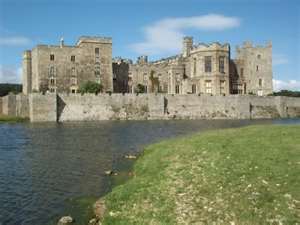
Raby Castle [Earl of Darlington's], Feb. 16th, 1825.
". . . This house is itself by far the most magnificent and unique in several ways that I have ever seen. Then what are we to say of its being presided over by a poplolly! A magnificent woman, dressed to perfection, without a vestige of her former habits — in short, in manners as produceable a countess as the best blood could give you. ... As long as I have heard of anything, I have heard of being driven into the hall of this house in one's carriage, and being set down by the fire. You can have no idea of the magnificent perfection with which this is accomplished. Then the band of musick which plays in this same hall during dinner! then the gold plate!! and then— the poplolly at the head of all!!!'"
Note: The 3rd Earl of Darlington was created Duke of Cleveland in 1833. By his second wife, alluded to above, who died in 1861, he had no children.
Poplolly - From the French poupelet, meaning literally "little darling." In Creevey's time, a derogatory term, often used when referring to kept women or mistresses.
Creevey (Lord love him) continues to accept Lady Darlington's hospitality whilst sneering at her behind her back -
Raby, 20th Feby. (1825)
". . . My lady [Darlington] drove me about and shewed me many lions I had not seen before. I am compelled to admit that, in the familiarity of a duet and outing, the cloven foot appeared. I don't mean more than that tendency to slang, which I conceive it impossible for any person who has been long in the ranks entirely to get overt. To be sure when I gaze at these three young women,* and at this brazen-faced Pop who is placed over them, and shews that she is so, the whole transaction — I mean the marriage, appears to me the wickedest thing I ever heard of; for altho' these young ladies appear to be gifted with no great talents, and altho' they have all more or less of the quality squall, yet their manners are particularly correct and modest. . . ."
*Lord Darlington's daughters by previous marriage
By June 6th, 1825, Creevey is writing " . . . Our dinner at Bruffman's yesterday was damnable in cookery, comfort, and everything else, tho' the dear Countess of Darlington was there, better dressed and looking better than any countess in London . . . ."
Five months on, it appears as though Lady Darlington has finally, and completely, won Creevey over. He writes -
Nov. 3, (1825) Newton House [Earl of Darlington's hunting box, Yorkshire].
". . Nothing on earth can be more natural and comfortable than we all are here. The size of the house, as well as of the party, makes it more of a domestic concern than it is at Raby, and both he and she shine excessively in this point of view. As for her [Lady Darlington] I consider her a miracle. To see a ' bould face ' turn into a countess, living in this beautiful house of her own, and never to shew the slightest sign of being set up, is so unlike all others of the kind I have seen, that she must be a very sensible woman. Then she is so clean, and she is looking so beautiful at present. . . ."
So, what did Creevey have against Lady Darlington? William Henry Vane, 3rd Earl of Darlington, 1st Duke of Cleveland (1766-1842) married his cousin, Lady Catherine Powlett (1766–1807), a daughter of the 6th Duke of Bolton.
The Duke's (although he was at the time just the 5th Baron Barnard and 3rd Earl of Darlington, and no more - he became Marquis of Cleveland in 1827, and Duke of Cleveland in 1833) second marriage, to Elizabeth Russell, took place on 27th July 1813 at William Harry's London residence at 31 St James Square, by 'special licence', about six years after the death of his first wife Katherine. It's difficult to determine how long the Duke had known Elizabeth before their marriage - or how well.
In any case, his marriage to Elizabeth 'outraged polite society,' it is recorded (even in Burke's Peerage). Quite probably, it outraged Catherine Powlett's mother the most - said mother being the last Duchess of Bolton, also named Katherine Powlett (though née Lowther) - and, worse, she was sister to the Duke's own mother - thus both his mother-in-law and his aunt. That she was dead set against the Duke's second marriage to Elizabeth becomes obvious when we learn that all seven surviving children from Catherine & William's marriage changed their surnames in 1813, to Powlett (or Vane Powlett) on the express instructions of the Duchess of Bolton's Will.
So - what did so many have against the second Lady Darlington? Elizabeth Russell was a market gardener's daughter - he being Robert Russell of (the above mentioned) Newton House in Burmiston (also written Burnestone, now Burneston), in the county of North Yorkshire. Her father's unexalted station in life was one thing, but Elizabeth's own reputation was quite another - she'd made a 'name' for herself by being the mistress of Thomas Coutts, the banker whose name is still remembered as the famous bankers for the Royal Family in the Strand, London.
As Creevey's pen attests, Lady Darlington obviously had a winning personality, which in no way affected the advancement of her husband through the peerage. The 3rd Earl was created Marquess of Cleveland in 1827 and Duke of Cleveland in 1833. These titles, and the Earldom of Darlington, became extinct on the death of the 4th Duke (and 6th Earl) in 1891. The barony of Barnard remains extant.
You can visit the Raby castle website here.

Raby Castle [Earl of Darlington's], Feb. 16th, 1825.
". . . This house is itself by far the most magnificent and unique in several ways that I have ever seen. Then what are we to say of its being presided over by a poplolly! A magnificent woman, dressed to perfection, without a vestige of her former habits — in short, in manners as produceable a countess as the best blood could give you. ... As long as I have heard of anything, I have heard of being driven into the hall of this house in one's carriage, and being set down by the fire. You can have no idea of the magnificent perfection with which this is accomplished. Then the band of musick which plays in this same hall during dinner! then the gold plate!! and then— the poplolly at the head of all!!!'"
Note: The 3rd Earl of Darlington was created Duke of Cleveland in 1833. By his second wife, alluded to above, who died in 1861, he had no children.
Poplolly - From the French poupelet, meaning literally "little darling." In Creevey's time, a derogatory term, often used when referring to kept women or mistresses.
Creevey (Lord love him) continues to accept Lady Darlington's hospitality whilst sneering at her behind her back -
Raby, 20th Feby. (1825)
". . . My lady [Darlington] drove me about and shewed me many lions I had not seen before. I am compelled to admit that, in the familiarity of a duet and outing, the cloven foot appeared. I don't mean more than that tendency to slang, which I conceive it impossible for any person who has been long in the ranks entirely to get overt. To be sure when I gaze at these three young women,* and at this brazen-faced Pop who is placed over them, and shews that she is so, the whole transaction — I mean the marriage, appears to me the wickedest thing I ever heard of; for altho' these young ladies appear to be gifted with no great talents, and altho' they have all more or less of the quality squall, yet their manners are particularly correct and modest. . . ."
*Lord Darlington's daughters by previous marriage
By June 6th, 1825, Creevey is writing " . . . Our dinner at Bruffman's yesterday was damnable in cookery, comfort, and everything else, tho' the dear Countess of Darlington was there, better dressed and looking better than any countess in London . . . ."
Five months on, it appears as though Lady Darlington has finally, and completely, won Creevey over. He writes -
Nov. 3, (1825) Newton House [Earl of Darlington's hunting box, Yorkshire].
". . Nothing on earth can be more natural and comfortable than we all are here. The size of the house, as well as of the party, makes it more of a domestic concern than it is at Raby, and both he and she shine excessively in this point of view. As for her [Lady Darlington] I consider her a miracle. To see a ' bould face ' turn into a countess, living in this beautiful house of her own, and never to shew the slightest sign of being set up, is so unlike all others of the kind I have seen, that she must be a very sensible woman. Then she is so clean, and she is looking so beautiful at present. . . ."
So, what did Creevey have against Lady Darlington? William Henry Vane, 3rd Earl of Darlington, 1st Duke of Cleveland (1766-1842) married his cousin, Lady Catherine Powlett (1766–1807), a daughter of the 6th Duke of Bolton.
The Duke's (although he was at the time just the 5th Baron Barnard and 3rd Earl of Darlington, and no more - he became Marquis of Cleveland in 1827, and Duke of Cleveland in 1833) second marriage, to Elizabeth Russell, took place on 27th July 1813 at William Harry's London residence at 31 St James Square, by 'special licence', about six years after the death of his first wife Katherine. It's difficult to determine how long the Duke had known Elizabeth before their marriage - or how well.
In any case, his marriage to Elizabeth 'outraged polite society,' it is recorded (even in Burke's Peerage). Quite probably, it outraged Catherine Powlett's mother the most - said mother being the last Duchess of Bolton, also named Katherine Powlett (though née Lowther) - and, worse, she was sister to the Duke's own mother - thus both his mother-in-law and his aunt. That she was dead set against the Duke's second marriage to Elizabeth becomes obvious when we learn that all seven surviving children from Catherine & William's marriage changed their surnames in 1813, to Powlett (or Vane Powlett) on the express instructions of the Duchess of Bolton's Will.
So - what did so many have against the second Lady Darlington? Elizabeth Russell was a market gardener's daughter - he being Robert Russell of (the above mentioned) Newton House in Burmiston (also written Burnestone, now Burneston), in the county of North Yorkshire. Her father's unexalted station in life was one thing, but Elizabeth's own reputation was quite another - she'd made a 'name' for herself by being the mistress of Thomas Coutts, the banker whose name is still remembered as the famous bankers for the Royal Family in the Strand, London.
As Creevey's pen attests, Lady Darlington obviously had a winning personality, which in no way affected the advancement of her husband through the peerage. The 3rd Earl was created Marquess of Cleveland in 1827 and Duke of Cleveland in 1833. These titles, and the Earldom of Darlington, became extinct on the death of the 4th Duke (and 6th Earl) in 1891. The barony of Barnard remains extant.
You can visit the Raby castle website here.
Published on May 09, 2011 00:56
May 8, 2011
Curiosity Corner - We Have a Winner!

Kat has correctly guessed that the sitter in the portrait above is Sarah Trimmer, author of children's literature in the 18th Century. You can read more about Sarah here. Kat, email me and we'll straighten out the shipping instructions. Congratulations!
Who is it?
The first person to correctly identify the sitter will win this poster of Elizabeth Farren by Sir Thomas Lawrence from the Regency Power and Brilliance exhibition at the National Portrait Gallery in London.

Poster measures 20.5" x 30" or 510mm x 765mm
Please place your guess by using the "comments" link below this post.
Please Note : If you're our winner, and you're also a follower, there's a second prize in store for you. Register now by using the link in the right sidebar under "Those Who Call Number One London Home."
Good Luck!
Published on May 08, 2011 00:28
May 7, 2011
For Sale: Alton Manor Nr. Wirksworth, Derbyshire
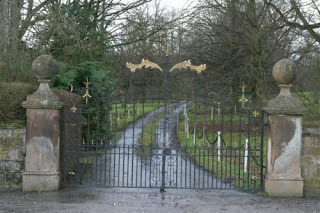
On May 12th, Graham Penny Auctions will be selling Alton Manor, a Grade II Listed, 14 bedroom manor house situated on 26 acres in Derbyshire. The estate boasts a tree lined drive with gate house, walled garden, icehouse, brew house, kennels, a lake (trout stocked) and boat house, a stone courtyard with 4 coach houses and stabling and a separate lodge house complete with two bedrooms, two reception rooms and its own garden. Bidding will start at one million pounds.
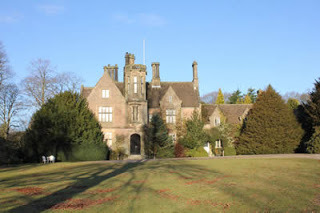
Lady Winifred Hilton lived in the house for more than 50 years and sadly passed away last year at age 91. She was the widow of the former Lord Lieutenant of Derbyshire, Sir Peter Hilton, and she was born Winifred Smith at Tansley, near Matlock, in 1919. Lady Hilton served in the Women's Auxiliary Air Force in the Second World War, when she was posted to Liverpool and then Northern Ireland, working in special operations on radar, decoding and cyphers. In 1942, she married Sir Peter, whom she met two years earlier when he was billeted in Matlock after being evacuated from Dunkirk. For a truly amazing story regarding Sir Peter and his father, Richard, and their similar war injuries and the doctor who operated on them both, in two separate wars, click here.
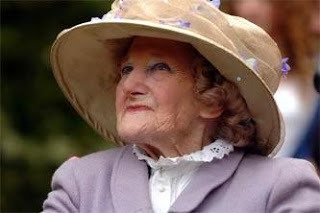 Lady Winifred Hilton
Lady Winifred Hilton
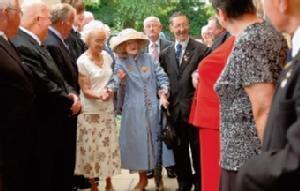 Lady Hilton at her 90th birthday party at The Spot, in Secheveral Street, Derby
Lady Hilton at her 90th birthday party at The Spot, in Secheveral Street, DerbyThe Manor originally contained 480 acres. It was held by the Byrons for three or four centuries, and afterwards belonged successively to the Blackwalls, Iretons, and Mellors. From the latter it was purchased by the Hon. Anchetil Grey, whose relative, the Earl of Stamford, sold it in 1747 to the Wilmots, from whom it was purchased by the late James Milnes, Esq. It then passed to that gentleman's eldest son, who assumed the name of Walthall in lieu of Milnes under the will of his maternal grandfather. A handsome mansion, in the Elizabethan style, was built in 1846-7 by the late Mr. Milnes. The History, Topography and Directory for Derbyshire (1895) adds: "Alton Manor, which forms part of the township, contains 480 acres. It was held by the Byrons for three or four centuries, and afterwards belonged successively to the Blackwalls, Iretons, and Mellors. From the latter it was purchased by the Hon. Anchetil Grey, whose relative, the Earl of Stamford, sold it in 1747 to the Wilmots, from whom it was purchased by the late James Milnes, Esq. The present owner is that gentleman's eldest son, who assumed the name of Walthall in lieu of Milnes under the will of his maternal grandfather. A handsome mansion, in the Elizabethan style, was built in 1846-7 by the late Mr. Milnes." Noted architect Sir Gilbert Scott built Alton Manor to a Jacobean style in an attractive mellow ashlar stone.
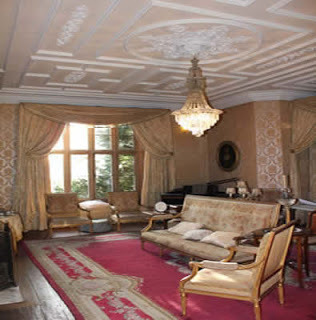
Today, Alton Manor still boasts such original features as twin oak entrance doors, oak panelled hallways, Hopton stone floors and fireplaces, mullioned and transomed windows, turret, butler's pantry, intact servant's bells and pantry, housekeeper's sitting room and gun room. Who says a million pounds won't buy much these days?
Published on May 07, 2011 00:53
Kristine Hughes's Blog
- Kristine Hughes's profile
- 6 followers
Kristine Hughes isn't a Goodreads Author
(yet),
but they
do have a blog,
so here are some recent posts imported from
their feed.



